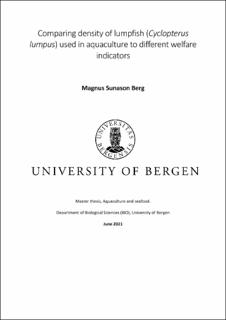Comparing density of lumpfish (Cyclopterus lumpus) used in aquaculture to different welfare indicators
Master thesis
Permanent lenke
https://hdl.handle.net/11250/2762433Utgivelsesdato
2021-05-31Metadata
Vis full innførselSamlinger
- Master theses [267]
Sammendrag
Farmed lumpfish are commonly used as cleaner fish in the salmonid aquaculture industry, but a knowledge gap exists with regards to their density. Filling this knowledge gap is of importance, as the lumpfish have no swim bladder and thus relies heavily on its lipid storage for buoyancy, i.e. the density difference between the fish and its surroundings. The aims of this study were to measure the density of lumpfish and investigate the correlation between density and different welfare indicators. Furthermore, the results were compared to existing literature that investigated density of adult wild lumpfish. 138 lumpfish were sampled at four different aquaculture sites situated in the Faroe Islands. The lumpfish were caught with a dipnet and euthanized with Finquel. Weight in water and air was measured and the density was calculated. Welfare indicators such as Fulton´s K, liver colour, hepatosomatic index, length, weight, skin, fin, and stomach fulness scores were measured. The average density of the juvenile lumpfish was 1.030 g mL-1 which was reminiscent of existing literature. Fulton´s K, stomach score, and length had a negative influence on density, while the hepatosomatic index had a positive influence on density. Tukey’s post hoc test showed that liver colour also influenced density, but the groupings were too broad to conclude anything. The knowledge gained from this study will help the industry improve their understanding of the welfare parameters used for lumpfish. Additionally, the knowledge might also help the aquaculture industry improve their husbandry and feeding practices.
